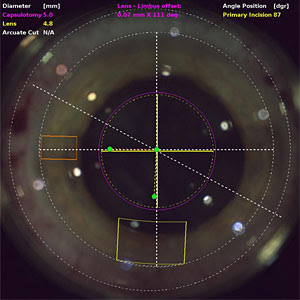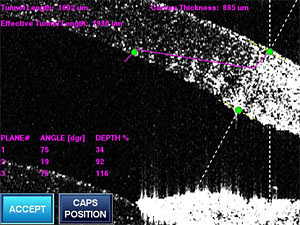Malik Eye Care is New York’s premier cataract surgery specialists providing personalized and precision care for your eyes.
A cataract is a clouding of the eye’s natural lens, which lies behind the iris and the pupil. The lens works much like a camera lens, focusing light onto the retina at the back of the eye. The lens also adjusts the eye’s focus, letting us see things clearly both up close and far away.
The lens is mostly made of water and protein. The protein is arranged in a precise way that keeps the lens clear and allows light to pass through it. As we age, some of the protein may clump together and start to cloud a small area of the lens. This is a cataract, and over time, it may grow larger and cloud more of the lens, making it harder to see.
Researchers are gaining additional insights about what causes these specific types of proteins (crystallins) to cluster in abnormal ways to cause lens cloudiness and cataracts. Recent findings suggest that fragmented versions of these proteins bind with normal proteins, disrupting normal function.
Cataracts are classified as one of three types:
- A subcapsular cataract begins at the back of the lens. People with diabetes, high farsightedness, retinitis pigmentosa or those taking high doses of steroids may develop a subcapsular cataract.
- A nuclear cataract is most commonly seen as it forms. This cataract forms in the nucleus, the center of the lens, and are due to natural aging changes.
- A cortical cataract, which forms in the lens cortex, gradually extends its spokes from the outside of the lens to the center. Many diabetics develop cortical cataracts.
For more information about cataracts & cataract surgery, request an appointment with Malik Eye Care serving the people of Manhattan, Jackson Heights, Hollis, Forest Hills, Hicksville and more.
Cataract Surgery
The femtosecond laser technology that brought new levels of safety, accuracy, and predictability to LASIK surgery is also advancing cataract surgery. In laser cataract surgery, an advanced femtosecond laser replaces or assists the use of a hand-held surgical tool for the following steps in cataract surgery:
- The corneal incision
- The anterior capsulotomy
- Lens and cataract fragmentation
- Astigmatism correction
Use of a laser can improve the precision, accuracy, and reproducibility of each of these steps, potentially reducing risks and improving visual outcomes of cataract surgery.
The Corneal Incision
Traditional cataract surgery is one of the most frequently performed surgeries and also one of the safest and effective, with predictable outcomes. It is highly dependent on surgeon skill, volume, and experience.


Optical coherence tomography is an imaging technology that helps your cataract surgeon to plan the location and depth of incisions made during a laser-assisted cataract surgery procedure. OCT scans offer high-resolution and even cross-sectional images, to make the cataract surgery as precise as possible. (Images: Vance Thompson, MD)
The first step in cataract surgery is making an incision in the cornea. In traditional cataract surgery, the eye surgeon uses a hand-held metal or diamond blade to create an incision in the area where the cornea meets the sclera. This incision allows the surgeon to gain access to the interior of the eye to break up and remove the cataract, which is a clouding of the eye’s natural lens that is located right behind the pupil. Next, an intraocular lens (IOL) is inserted and implanted, to replace the cloudy natural lens.
The corneal incision is made in a special way so it will self-seal when surgery is complete, without any need for stitches.
In laser cataract surgery, the surgeon creates a precise surgical plan for the corneal incision with a sophisticated 3-D image of the eye called an OCT (optical coherence tomography). The goal is to create an incision with a specific location, depth, and length in all planes, and with the OCT image and a femtosecond laser, it can be performed exactly without the variable of surgeon experience.
This is important not only for accuracy but also for increasing the likelihood that the incision will be self-sealing at the end of the procedure, which reduces the risk of infection.
The Capsulotomy
The eye’s natural lens is surrounded by a very thin, clear capsule. In cataract surgery, the front portion of the capsule is removed in a step called an anterior capsulotomy, to gain access to the cataract. It is very important that the remainder of the lens capsule that remains intact in the eye is not damaged during cataract surgery, because it must hold the artificial lens implant in place for the rest of the patient’s life.
In traditional cataract surgery, the surgeon creates an opening in the capsule with a small needle and then uses that same needle or a forceps to tear the capsule in a circular fashion. In laser cataract surgery, the anterior capsulotomy is performed with a femtosecond laser. Studies have shown that capsulotomies performed with a laser have greater accuracy and reproducibility.
Studies also have shown that laser capsulotomies enable better centering of the intraocular lens, and IOL positioning is a significant factor in determining final visual outcomes.
Lens and Cataract Fragmentation
After the capsulotomy, the surgeon now has access to the cataract to remove it. In traditional cataract surgery, the ultrasonic device that breaks up the cataract is inserted into the incision. During this phacoemulsification procedure, the ultrasound energy can lead to heat buildup in the incision, which sometimes can burn the incision and negatively affect the visual outcome by actually inducing astigmatism.
- Procedure time: about 20 minutes
- Typical results: long-lasting clear vision (at all distances with presbyopia-correcting IOLs)
- Recovery time: about a month
An incision burn also has a higher chance of leaking and sometimes needs multiple sutures to close. The smaller the incision we use, the more this issue is important to consider.
The laser, on the other hand, softens the cataract as it breaks it up. By breaking up the cataract into smaller, softer pieces, less energy should be needed to remove the cataract, so there should be less chance of burning and distorting the incision.
Laser cataract surgery may also reduce the risk of capsule breakage. After the calculation of the proper implant power, there is no step more important for visual outcome than the preservation of the capsule that the natural lens sat in. This capsule is as thin as cellophane wrap and it’s important that the portion that is left inside the eye after cataract surgery is undamaged, so it can hold the IOL in the proper position for clear, undistorted vision.
The reduced phacoemulsification energy required in laser cataract surgery may also make the procedure safer to the inner eye, which reduces the chance of certain complications, such as a detached retina.
Astigmatism Correction at the Time of Cataract Surgery
To reduce the need for prescription eyeglasses or reading glasses after cataract surgery, it is important that little or no astigmatism is present after implantation of presbyopia-correcting multifocal IOLs and accommodating IOLs.
Astigmatism usually is caused by the cornea being more curved in one meridian than others (in other words, it’s shaped somewhat like a football). To reduce astigmatism, small incisions can be placed in the periphery of this more curved meridian; as the incisions heal, this meridian flattens slightly to give the cornea a rounder, more symmetrical shape (like a baseball).
This procedure is called limbal relaxing incisions (LRI) or astigmatic keratotomy (AK). Surgeons can perform LRI or AK manually with a diamond blade, and it is quite effective in reducing astigmatism.
During refractive laser-assisted cataract surgery, the OCT image can be used to plan laser LRI or AK incisions in a very precise location, length, and depth. This increases the accuracy of the astigmatism-reducing procedure and increased the probability of good vision without glasses after cataract surgery.
For more information about Laser Cataract Surgery in Manhattan and throughout New York, contact Malik Eye Care today! Our practice has convenient offices in Manhattan, Jackson Heights, Hollis, Forest Hills, and Hicksville, NY.


